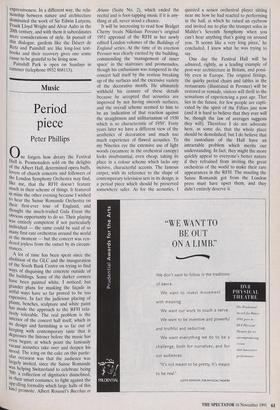Architecture
Le Desert de Retz: a Late 18th-century Folly Garden (RIBA Heinz Gallery, till 19 December)
Follies of grandeur
Alan Powers
The English landscape garden of the 18th century is a well-known part of our national history. Less so the French equiva- lent, the jardin anglo-chinois as it was known in its brief flowering before the Revolution. This is partly because few examples have survived with a complete- ness comparable to Stowe, Rousham or Stourhead, although many were illustrated
by engravings in their heyday. Among these, the greatest curiosity is the Desert de Retz, the wooded park at Chambourcy, 12 miles west of Paris, created by the wealthy dilettante Racine de Monville between 1774 and 1789. He was 'corn- pagnon de plaisir' of Philippe Egalite, the Duke of Orleans, as well as being a lover of Madame du Barry and a friend of Beau- marchais. 'Desert' was the term used for a wild area within a formal garden. Monville's Desert was wild in more ways than one. It contained a number of struc- tures in Chinese and Gothic styles, includ- ing a genuine ruin as well as de Monville's masterpiece, the Broken Column, a house built in the form of the lower part of a vast classical column, 50 feet high to its artifi- cially ragged top, and originally furnished inside with great luxuriousness.
The Desert de Retz was never entirely forgotten. During years of benign neglect, it was visited by Colette, Abel Gance and the Surrealists. Its preservation is owed to Olivier Choppin de Janvry, an architect who first visited the site in 1960 as a stu- dent and has steered its restoration since acquiring the property in 1983. Having been one of the circle of initiates who found the way into the unguarded but elu- sive Desert in 1979, I am greatly impressed by the works achieved so far, although the Chinese House, which collapsed into the lake in 1972, has yet to be replaced. As The Broken Column in the Desert de Retz, photographed by Michael Kenna in 1988 Diana Ketcham, the curator of this travel- ling exhibition from San Francisco, describes it, the spatial feeling of the early drawings of the Desert has been recaptured by clearing away the saplings in front of the Broken Column and replacing the original meadow. The exhibition consists of the rare complete series of engravings by Le Rouge and a set of photographs from 1988 bY Michael Kenna, simple enough ingredients for stimulating the imagination. The Desert itself may be visited one Sunday a month during the summer (telephone Paris 39769037).
Landscape gardening was a leading art form of the Enlightenment, allowing for the theoretical and practical exploration of man's relationship to nature, understood through classical mythology and association but orchestrated in three dimensions almost like a film. In recapturing the sense of movement through space, light and atmosphere, the reconstruction of the orig- inal gardens increases our understanding more than the best sets of documents. They are not just collections of funny, eccentric buildings, but composed works with a seri- ous message. Thomas Jefferson visited the Desert in 1786. He also visited Painshill, Charles Hamilton's famous landscape park near Cobham, Surrey, which has been undergoing restoration by the Painshill Park Trust since 1981. Like the Desert, Painshill was famous but paradoxically vir- tually forgotten as a physical survival, its park parcelled out in a sale in 1946.
The parallels are striking. Although Painshill is nearly 40 years earlier, it was a garden conceived for its own sake, lacking a grand mansion since Hamilton was only the ninth son of the Duke of Abercorn. Most of the important French garden architects to visit England saw Painshill because of its proximity to London and its fame in creating wild nature through art. Hamilton acted largely as his own designer, as did Monville, and introduced a grandeur of scale into the intricate prettiness of the rococo. His Grotto, already half rebuilt with fluorspar stalactites, is not a shelly fantasy but a sublime experience, originally assisted by the head gardener working an Archimedean screw to raise water up to the roof, making the inner surface glitter. Apart from Jefferson, King Gustav III of Sweden visited the Desert, and his garden designer F.M. Piper also visited Pairishill, recording all the features. At Drott- ningholm and Haga, Gustavus built copper tents like the Turkish Tents at Painshill (to be rebuilt in 1992) and the smaller examp/e already restored at the Desert.
Garden buildings like these profoundly altered architects' sensibilities in the late 18th century, particularly in France where academic classicism had the strongest hold. Architects learnt to see more three' dimensionally by considering the building in its landscape. They also expanded their horizons to explore other civilisations and cultures, achieving a greater degree of expressiveness. In a different way, the rela- tionship between nature and architecture dominated the work of Sir Edwin Lutyens, Frank Lloyd Wright and Alvar Aalto in the 20th century, and with them it subordinates mere considerations of style. In pursuit of this dialogue, gardens like the Desert de Retz and Painshill are like long-lost text- books and their recovery gives one some cause to be grateful to be living now. Painshill Park is open on Sundays in summer (telephone 0932 868113)











































































 Previous page
Previous page